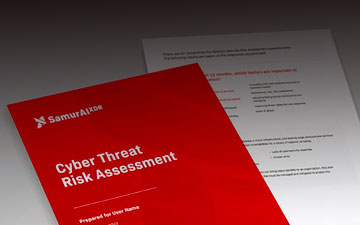Implementing effective cybersecurity is becoming increasingly challenging in the current cyberthreat landscape. Sophisticated threat actors are continuously developing innovative techniques designed to defeat traditional, legacy security solutions. Their new methods pose serious risks to the security of a company’s IT environment and valuable data resources.
Addressing modern threat actors requires an improved approach to cybersecurity that employs new strategies built on advanced technologies. Analytics made possible by artificial intelligence (AI) and machine learning (ML) offer functionality that can be incorporated into cybersecurity solutions and platforms. It’s important that these technologies are used efficiently to defend against emerging threats.
We are going to look at how behavior analytics can be used to help identify threats to the environment that escape detection from traditional cybersecurity measures. Effective use of behavior analytics can improve an organization’s security posture and better protect it from threat actors. We’ll also discuss how behavior analytics can enhance the threat detection capabilities of XDR solutions.
What is User Behavior Analytics (UBA)?
User behavior analytics employs AI and ML technology to track, collect, and analyze user activities to identify anomalies and abnormal behavior that may indicate the presence of a threat. The objective of UBA is to find patterns that may provide evidence of risks and threats to the IT environment.
UBA technology identifies suspicious behavioral patterns by consolidating historical data logs from networks, applications, and all components of the environment. A UBA system typically does not take action when discovering anomalies. Its purpose is to supply a cybersecurity team with actionable insights regarding unusual behavior.
- The risks UBA tries to detect include:
- Security breaches as unauthorized users access sensitive or regulated information;
- Data exfiltration as malicious insiders attempt to steal valuable information;
- Malicious activity that is not discovered by security measures or IT personnel.
Here is an example of the type of threat that can be uncovered through UBA. An organization is breached through a successful phishing attack that results in malware infecting the environment. The malware is designed to search for valuable data resources and communicate its findings by contacting an external server. UBA detects the breach by identifying user logins and attempts to transmit data out of the system from unusual locations and at unusual times. Security personnel can use this information to initiate an investigation and remove the malicious software from the environment.
What is User and Entity Behavior Analytics (UEBA)?
User and entity behavior analytics extends UBA by incorporating the concept that entities besides users can pose security risks to an IT environment. These entities may include applications, processes, or devices. Advances in technology have made it possible for these entities to be programmed or act autonomously to perform malicious acts in an IT infrastructure.
The addition of entities dramatically increases the volume of data processed by UEBA systems. The number of applications, devices, IoT endpoints, and other entities greatly exceeds the number of users interacting with an IT environment. Processing this volume of data requires advanced AI and ML technology. UEBA systems can produce more complex reports that can help security personnel protect systems and data resources.
Comparing UBA and UEBA
UBA and UEBA are similar in many respects.
- They both track the activities of users or entities as they interact with the computing environment in search of unusual behavior.
- The systems do not report all anomalies as risks. The analytical engines in the solutions evaluate the potential effects of the suspicious behavior. Risks are prioritized to help security teams address the most dangerous threats.
- Machine learning improves system functionality and reduces the incidence of false positives over time.
- The systems are effective at setting baseline behavioral patterns that can be monitored for deviations.
UEBA differs from UBA in several ways.
- UEBA is a newer technology.
- UEBA produces substantially more data that requires extensive analysis.
- UEBA tracks a combination of user and entity behavior for a more complete view of the risks to the environment.
How do UBA and UEBA Address Sophisticated Threat Actors?
Both UBA and UEBA are concerned with detecting unusual behavior and providing security teams with actionable insights that can be used to mitigate threats. The tools analyze logs from various infrastructure components and systems. This analysis can uncover subtle and suspicious behavior that may indicate the presence of malicious insiders or external threat actors.
The tools differentiate between normal and malicious or suspicious behavior and prioritize findings to minimize wasting time tracking down false positives.
UBA and UEBA systems do not typically take action when anomalies are discovered. Rather, they furnish pertinent information that can be addressed by security personnel.
How UBA and UEBA Complement XDR
The information available from UBA and UEBA platforms offers useful telemetry that can be incorporated into an organization’s overall cybersecurity posture. The insights garnered by UBA and UEBA provide enhanced data regarding potential threats to the environment and add a useful behavioral dimension to the telemetry available to extended detection and response (XDR) solutions.
XDR leverages telemetry from across the entire computing environment to go beyond traditional security monitoring solutions. As the sophistication of threat actors continues to grow, XDR platforms can only benefit from the addition of the information provided by UBA and UEBA systems.
An XDR platform improves an organization’s cybersecurity and threat detection capabilities in the following ways. They can all be affected by the inclusion of behavioral analytics.
- XDR provides a consolidated interface for the telemetry gathered by cybersecurity tools including UBA and UEBA platforms.
- XDR identifies sophisticated threats that escape detection by legacy tools. Behavioral analytics offers another channel for identifying potential threats.
- XDR identifies weak signals that may indicate an intrusion or the presence of advanced persistent threats. Similar functionality can be achieved with behavioral analytics monitoring anomalies that conflict with baseline patterns.
- The lateral movements throughout an environment that may indicate an intrusion are detected by XDR. UBA and UEBA solutions provide additional telemetry that enhances this capability.
- Both XDR and behavioral analytics prioritize threats and alert security personnel of suspicious behavior that needs to be addressed to ensure security.
- XDR can take action based on the insights provided by UBA and UEBA.
Samurai XDR is a cloud-based extended detection and response platform suitable for any size of business. It can be especially beneficial for small and medium-sized businesses (SMBs) that do not have extensive cybersecurity teams by prioritizing threats so they are more easily handled by security personnel. Samurai’s XDR solution integrates with existing cybersecurity solutions to provide the enhanced threat detection required to defend against sophisticated threat actors.
Contact Samurai and learn how XDR can help protect your organization’s IT environment and valuable data assets.
Featured articles
How Samurai XDR’s Threat Intelligence Protects Your Business
4 October 2023 | XDR
Attacks on IT environments are becoming increasingly sophisticated and harder to detect using traditional methodology. It is no longer enough...
How XDR Reduces Your Cybersecurity Workload
28 September 2023 | XDR
The security of a company’s IT environment is critical for its ability to effectively perform business operations. Mishandling sensitive information...
How XDR Simplifies Implementing Robust Cybersecurity
20 September 2023 | XDR
Implementing robust cybersecurity is a complex undertaking. The individuals responsible for securing an IT environment must have the knowledge and...


